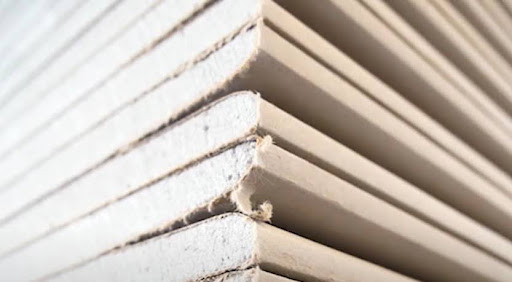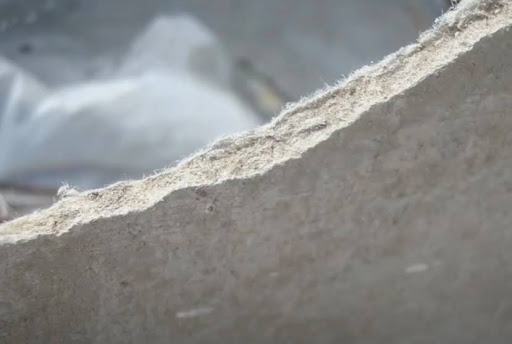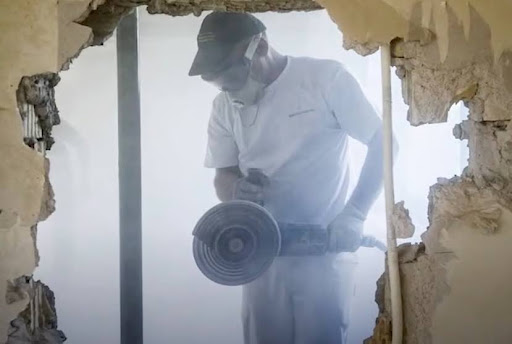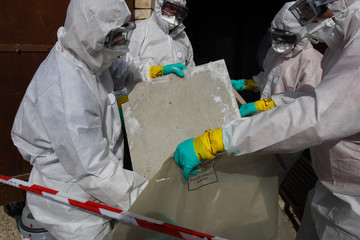Asbestos, once a popular material in construction, has been found to have serious health implications, especially when present in plasterboard. This article aims to provide an in-depth look into what asbestos in plasterboard means for your health, how to identify it, and the necessary steps to ensure safety. Keep reading to get informed about asbestos-plaster walls and what does asbestos look like in walls.
What is Asbestos?

Asbestos is a term used for a group of six naturally occurring silicate mineral fibers that possess remarkable resistance to heat, fire, and electricity, alongside high tensile strength. These fibers, due to their physical properties, were historically added to various building materials, including cement, roofing shingles, and notably plasterboard, to enhance strength, insulation, and fire resistance. However, the inherent health risks associated with asbestos exposure have led to its strict regulation and decline in use.
Asbestos in Plasterboard: Why the Concern?
Plasterboard, commonly known as drywall, is a construction material used to create walls and ceilings. It was common for plasterboard to contain asbestos fibers to leverage its durability and fire-resistant properties. The danger arises when these plasterboard walls or ceilings are disturbed or deteriorate over time. Activities like drilling, cutting, or demolition can release asbestos fibers into the air. Once airborne, these microscopic fibers can be inhaled or ingested, leading to significant health issues.
Health Risks of Asbestos Exposure
The inhalation of asbestos fibers can lead to several severe respiratory conditions:
Asbestosis
Asbestosis is a chronic and progressive lung disease caused by the inhalation of asbestos fibers, which leads to the scarring of lung tissue. It is a non-cancerous condition but can significantly impact respiratory function and overall health.
Asbestosis can result in several debilitating health effects, including:
| Health Effect | Description |
| Reduced Lung Function | Scarring of lung tissue hinders air exchange, causing shortness of breath. |
| Coughing and Wheezing | Persistent coughing and wheezing are common symptoms. |
| Increased Susceptibility to Infections | Weakened lungs are more prone to respiratory infections. |
| Chest Discomfort and Pain | Patients may experience chest tightness or pain. |
Exposure to asbestos is the primary risk factor for developing asbestosis. The duration and intensity of exposure play a crucial role in determining the severity of the condition. Smokers exposed to asbestos are at an even higher risk of developing asbestosis.
Lung Cancer
Asbestos exposure significantly elevates the risk of developing lung cancer. While asbestos-related lung cancer shares similarities with lung cancer caused by smoking, it is a distinct condition.
Lung cancer due to asbestos exposure can have severe health consequences, such as:
| Health Effect | Description |
| Aggressive Tumor Growth | Asbestos fibers can lead to the development of aggressive lung tumors. |
| Reduced Survival Rates | Lung cancer caused by asbestos exposure often has a poorer prognosis. |
| Symptoms Similar to Smoking | Symptoms include persistent cough, chest pain, and difficulty breathing. |
The primary risk factor for asbestos-related lung cancer is, unsurprisingly, exposure to asbestos. The risk is especially high among individuals who have been exposed to asbestos for extended periods. Furthermore, the risk is significantly exacerbated for individuals who both smoke and are exposed to asbestos.
Mesothelioma
Mesothelioma is a rare and aggressive cancer that primarily affects the lining of the lungs (pleural mesothelioma) or the lining of the abdomen (peritoneal mesothelioma). It is directly linked to asbestos exposure.
Mesothelioma is characterized by devastating health effects, including:
| Health Effect | Description |
| Rapid Disease Progression | Mesothelioma is often diagnosed at an advanced stage, making treatment challenging. |
| Limited Treatment Options | Surgical intervention, chemotherapy, and radiation therapy may be considered, but the prognosis is generally poor. |
| Severe Respiratory Symptoms | Symptoms include chest pain, shortness of breath, and persistent coughing. |
The primary risk factor for mesothelioma is asbestos exposure. Unlike other asbestos-related conditions, even brief exposure to asbestos can lead to the development of mesothelioma. Moreover, the risk remains elevated for several decades after exposure, making early detection and prevention crucial.
Identifying Asbestos in Plaster Walls

Identifying asbestos in plasterboard is not straightforward. Here’s what you need to know:
Appearance of Asbestos in Plaster Walls
Asbestos fibers themselves are microscopic and not visible to the naked eye, making it challenging to identify asbestos in plaster walls solely based on visual inspection. However, there are some visual clues and signs to look out for, especially in older plaster walls that may contain asbestos:
- Cracks and Deterioration: Asbestos-containing plaster may deteriorate over time, leading to visible cracks, fissures, or surface damage. Inspect the plaster carefully, particularly in areas where it appears damaged.
- Texture: Asbestos-containing plaster may have a unique texture, often described as “popcorn” or “cottage cheese” due to the inclusion of asbestos fibers. While this texture is not a definitive indicator, it can raise suspicions.
- Color: Asbestos-containing plaster is typically off-white or light gray in color, but this alone is not a conclusive sign.
- Patterns and Styles: Plaster walls in older buildings may exhibit specific patterns or styles that were common during the period when asbestos was commonly used. While this is not a definitive indicator of asbestos presence, it can be a clue.
Age of Building
The age of the building is a significant factor when determining the likelihood of asbestos in plaster walls. Buildings constructed or renovated between 1940 and 1980 are more likely to contain asbestos-containing materials, including plaster. During this period, asbestos was commonly used in construction due to its fireproofing and insulating properties. If you suspect that your building falls within this timeframe, it’s important to exercise caution.
Professional Testing for Asbestos in Plaster Walls
While visual inspection and historical knowledge can provide some indications, the only surefire way to confirm the presence of asbestos in plaster walls is through professional testing. Here’s how professional asbestos testing works:
- Hiring an Asbestos Inspector: Contact a licensed asbestos inspector or an environmental consulting firm with expertise in asbestos testing.
- Sample Collection: The inspector will collect samples from suspect areas, following proper safety procedures to minimize any asbestos fiber release during the process.
- Laboratory Analysis: The collected samples are sent to an accredited laboratory for analysis. Microscopic examination is performed to identify the presence and concentration of asbestos fibers in the samples.
- Results and Recommendations: Once the analysis is complete, the inspector will provide you with a detailed report of the findings. If asbestos is present, the report will also include recommendations for safe removal or containment.
DIY or Professional?
While it is generally not recommended to handle asbestos-containing materials on your own due to the potential health risks, there are situations where you may consider DIY removal. However, extreme caution and adherence to safety precautions are essential. Here are some key points to keep in mind if you decide to take on a small repair project involving asbestos in plasterboard:
Safety Gear
When attempting a DIY asbestos removal project, ensure you wear appropriate safety gear to minimize your risk of exposure. This safety gear includes:
- Disposable Coveralls: Cover your entire body to prevent asbestos fibers from adhering to your clothing.
- Respirator Mask: Use a high-efficiency particulate air (HEPA) respirator mask to protect your lungs from inhaling asbestos fibers.
- Gloves: Wear disposable gloves to avoid direct contact with asbestos-containing materials.
- Goggles: Protect your eyes from potential exposure to asbestos dust and fibers.
Wet Methods
Employ wet methods during removal to minimize the release of asbestos dust. Wet methods involve spraying asbestos-containing materials with water before handling them to reduce the likelihood of fibers becoming airborne.
Professional Removal
The safest and most recommended approach for handling asbestos in plasterboard is to hire professionals who specialize in asbestos abatement. Professionals have the necessary expertise, equipment, and training to safely remove and dispose of asbestos materials. Here are the key advantages of opting for professional removal:
Expertise
Asbestos abatement professionals possess the necessary expertise to handle asbestos-containing materials with precision and care. Their training enables them to:
- Identify Asbestos: Professionals can accurately identify asbestos-containing materials, including those within plasterboard. They use advanced techniques and tools like polarized light microscopy to confirm asbestos presence.
- Assess Risk: Upon identification, professionals assess the condition of the asbestos-containing material. They evaluate factors like friability (ease of crumbling) and potential for airborne asbestos fibers, allowing them to determine the level of risk involved.
- Implement Safe Strategies: Based on their assessment, professionals develop tailored removal strategies that prioritize safety and minimize asbestos exposure risks.
Safety Equipment
Professionals come equipped with specialized tools and safety gear that are crucial for ensuring the safety of both the workers and occupants of the building. This equipment includes:
- Negative Air Pressure Machines: These machines create a controlled environment that prevents the escape of asbestos fibers during removal. Air is continuously filtered and exhausted to the outside, reducing the risk of contamination.
- HEPA Vacuums: High-Efficiency Particulate Air (HEPA) vacuums are designed to capture tiny asbestos fibers effectively. They are used for thorough cleanup after the removal process.
- Protective Suits: Professionals wear full-body protective suits, along with gloves, masks, and respirators, to shield themselves from asbestos exposure.
Legal Compliance
Licensed asbestos abatement professionals are well-versed in the complex regulatory requirements and legal obligations related to asbestos removal and disposal. They ensure full compliance with local and federal regulations, which typically include:
- Obtaining Proper Permits: Professionals obtain the necessary permits required for asbestos removal, ensuring that the work is conducted legally and transparently.
- Notification: In many jurisdictions, there is a legal requirement to notify relevant authorities and nearby property owners before commencing asbestos removal.
- Proper Handling and Transportation: Professionals adhere to strict protocols for safely packaging and transporting asbestos waste to approved disposal facilities.
Proper Disposal
Asbestos waste must be disposed of in strict accordance with environmental regulations to prevent environmental contamination and health hazards. Professional removal includes:
- Secure Packaging: Asbestos-containing materials are securely sealed and labeled for transport to designated disposal sites.
- Approved Disposal Facilities: Professionals have access to approved facilities specifically designed for asbestos disposal, where waste is safely and permanently stored.
- Documentation: Detailed records are maintained throughout the removal and disposal process to demonstrate compliance with regulations.
Legal and Safe Disposal of Asbestos
Disposing of asbestos-containing materials must comply with local regulations, usually involving specialized facilities and methods to prevent environmental contamination.
Methods for Legal and Safe Asbestos Disposal
To ensure the proper disposal of asbestos-containing materials, the following methods are commonly employed:
- Specialized Facilities: Asbestos disposal is typically carried out at specialized facilities designed to handle hazardous materials safely. These facilities are equipped with containment structures, ventilation systems, and staff trained in asbestos removal.
- Containerization: Asbestos materials should be double-bagged in thick, leak-proof plastic bags specifically designed for asbestos disposal. These bags are labeled with warning signs indicating the presence of asbestos.
- Sealing and Labeling: Sealing the bags securely with duct tape and labeling them as “Asbestos Waste” is a crucial step to prevent accidental exposure and ensure proper handling.
- Transportation: Asbestos waste should be transported by licensed and certified carriers equipped to handle hazardous materials. The waste must remain securely contained during transit to prevent fiber release.
- Documentation: Accurate records, including manifests and disposal documentation, should be maintained throughout the disposal process to track the asbestos waste’s journey from generation to final disposal.
Regulatory Requirements for Asbestos Disposal
Local regulations governing asbestos disposal may vary, but they typically include the following key requirements:
- Permits: Depending on your location, you may need permits or approvals to transport and dispose of asbestos-containing materials.
- Notification: Notification to relevant authorities or agencies before asbestos removal and disposal may be mandatory.
- Waste Disposal Fees: Be prepared to pay disposal fees associated with asbestos waste, as these costs are often incurred by the generator.
- Record Keeping: Detailed records of asbestos waste generation, transport, and disposal must be maintained for a specified period.
Conclusion
Asbestos in plasterboard is a serious health concern that requires awareness and appropriate handling. Identifying, managing, and safely removing asbestos is crucial to prevent the severe health risks associated with asbestos exposure. If you suspect asbestos in your home, take immediate steps to have it assessed and, if necessary, removed by a professional. Remember, safety and health come first when dealing with asbestos in plaster walls.
By understanding the risks and proper procedures related to asbestos in plasterboard, you can ensure a safer living environment and better health outcomes. Stay informed, stay cautious, and always prioritize professional guidance when dealing with asbestos.
FAQs
How can I tell if my plasterboard contains asbestos?
You cannot confirm the presence of asbestos in plasterboard visually. If your home was built or renovated between 1940 and 1980, it might contain asbestos. Professional testing is the most reliable method.
Is it safe to live in a house with asbestos in plasterboard?
If the asbestos-containing materials are intact and undisturbed, they might not pose an immediate risk. However, any damage or renovation can release asbestos fibers, necessitating professional assessment and possibly removal.
What should I do if I find asbestos in my home?
Do not attempt to remove or disturb it. Contact a professional asbestos removal service to handle it safely.
Can I prevent asbestos exposure?
Prevent exposure by maintaining asbestos-containing materials in good condition, avoiding DIY removal, and having renovations conducted by professionals aware of and capable of managing asbestos risks.




